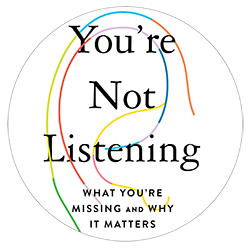
We’ve all heard the old advice: to be a better listener, you should nod your head, make eye-contact, and avoid interrupting. But if you do all those things, yet fail to really listen, all you’re doing is making yourself look like a good listener in order to get what you want.
In her book, You’re Not Listening: What You’re Missing and Why it Matters, Kate Murphy dives into the deep end of authentic listening. She encourages us to go to the heart of why we listen (to know and understand humans) and why that matters (because humans are valuable and deserve our care and attention, just as we deserve theirs). It’s not a book specifically for educators, but it speaks directly to human connection and the cultural and technological moment in which we find ourselves. I think any teacher, leader, parent, or human being of any stripe will find Murphy’s message powerful. If I could wave a magic wand and grant school leaders an essential superpower to address the chaos and constant change in schools right now, it would be to become a better listener.
So, are you really listening to those around you? I think we all mean to, but we’re human and…we often fall short of our best intentions. Taken from the pages of Murphy’s exploration, here are eight ways you can become a better listener, deepen your connections, and change your interactions for the better.
#1 Be Curious
Aim to learn something new in each conversation. You already know about yourself. Listen for what you do not know: the other person’s perspective. Being curious does not mean lobbing a lot of questions at someone. What’s your job? Are you married? What are your hobbies? This tends to make people defensive or steer the interaction toward the superficial. Instead, ask questions out of genuine curiosity, look for something the two of you have in common, and listen for what they would like to tell you.
Being curious is especially helpful if you find yourself listening to someone with whom you disagree. Instead of listening for the flaws in the other person’s argument, try listening for evidence that you might be wrong. When you engage in this kind of higher-order thinking, you also ease your brain’s fight-or-flight response to the opposing viewpoint. You will have a more productive conversation if your pulse is not racing as if you were trying to outrun a bear. Allowing our convictions to be challenged is the path toward becoming more secure and confident in our thinking. Listen, ask genuine questions, and aim for a complete understanding of the other person’s point of view as well as your own.
#2 Don’t Assume
Our minds love to categorize, generalize and create short-cuts. Short-cuts can serve us well by making complicated tasks easier. But when it comes to listening, your short-cuts are not serving you.
Assumptions get in the way when we listen to strangers. Someone’s appearance and surface-level details such as where they’re from nudge us to make assumptions about what they’re saying or what they probably think. Likewise, we tend to assume that people who seem similar to ourselves will share our beliefs. These assumptions, whether correct or incorrect, lead us away from listening and steal the opportunity to form a connection with that person.
Assumptions also get in the way when we listen (or fail to listen) to our close friends and family members. The better you know someone, the more likely you are to assume you know what they’re going to say. But if you miss opportunities to listen, you will begin to grow apart. Murphy says, “Listening is how we stay connected as the pages turn in our lives.”
#3 Listen for Why
If someone is telling you something, it almost certainly means something to them. Your job, as the listener, is to discover why they are you telling you this and how they feel about it.
If your colleague says she’s moving to a new office, she could feel proud because it signals an upward move in her career, or annoyed because it means she has to spend precious time packing, or sad because you and she won’t be able to chat as often. If you miss the emotional content of her message and respond as if she’s just delivering meaningless data (“Oh, OK”) then it’s like she tossed you a ball and you kept your arms pinned to your sides. If you’re unsure of the emotional content, ask questions and encourage elaboration.
Active listening is not so much about nodding or paraphrasing as it is about arriving at an actual place of understanding. Aim to understand not just what was said, but why it was said and how the speaker feels.
#4 Listen Like You’re Meditating
People who are learning to meditate are often coached to acknowledge distractions or straying thoughts, and then return their focus to their breath. Stray thoughts are impossible to stamp out completely, but experienced meditators know that you can train yourself to pay them less mind.
Murphy recommends we try something similar when listening. As you listen to another person speak, your brain wanders in its excess cognitive capacity. In fact, the smarter you are, the more capacity your brain may have to wander. You half listen and half think about random things that occur to you, and soon you’ve missed much of what the speaker had to say. This can lead you to fill in the gaps with your assumptions, and then even further miss the opportunity for connection and understanding.
As you listen, try becoming aware of what your brain wants to do with its excess capacity. Acknowledge your thoughts about what’s for dinner, or what errands need to be done later, but practice dismissing these thoughts and returning your attention to the speaker. You will likely never stop wandering thoughts from popping up, but it is worth learning how to refuse to give them your focus.
#5 Aspire to Understand (Beyond Data)
In education, we use data in tons of useful ways, we don’t like to make decisions without it, and we rely on it to find new and better ways of helping teachers teach and kids learn. But sometimes, looking for an answer in a data set can be a bit like looking for lost keys in the pool of light under a lamppost. Just because that’s where you can see, doesn’t mean you’ll find what you’re looking for there.
Murphy does not recommend we leave data behind as we pursue listening, but she believes they are best used together. Data-driven approaches to decision-making have the advantage of keeping the decision-maker’s bias out of the way. But they are limited by what is (and is not) in the data set. And what can never be in the data set is deep understanding. The data will tell what but never why. Listening, on the other hand, is just the opposite. When we listen, we aspire to understand why. The what and the why together are more valuable than either one alone.
#6 Support the Conversation (Don’t Shift It)
When someone tries to talk to you, especially about something difficult, choose a response that supports the conversation instead of shifting it. Shifting responses might refocus the conversation onto yourself—“That happened to me once.” Or they might change the subject entirely—“You’ll feel better after you eat. Let’s go get dinner.” Shifting responses also might stay on topic, but steer the conversation in the direction you think it should go—“I’m not surprised! Aren’t you mad?” Supporting responses, on the other hand, accept the speaker’s invitation to into the conversation. You might say, “How did you react?” or “How did you feel about that?” or “What would that mean to you?” Supporting responses communicate to the speaker that you are ready to listen and do not intend to dismiss or manipulate what they have to say.
#7 Set the Stage
Create an environment in which real listening is possible. Minimize distractions and background noise. And—let’s cut to the chase here—quit looking at your phone. Research shows that even the visible presence of a phone makes people less likely to talk about anything important and makes everyone feel more disconnected. It sounds cynical but the temptations of the phone can make the humans in the room feel like just one more device for the user to toggle between-—check-in, check-out, check your phone. If you do this, you’re giving out a constant signal that the people around you are unimportant or uninteresting.
#8 Allow Silence
Get comfortable with pauses in conversation. If you jump in too quickly to fill the gap, you might be preventing the speaker from elaborating, or even from expressing an idea they’re struggling to communicate. Americans, in particular, tolerate about half the length of silence as people from some other cultures. In Finland, for example, it is considered overbearing and impolite to speak too soon after another person finishes. Allow people time and space to gather their thoughts. Murphy tells about a furniture salesman who was known for his unusually high tolerance for silence, which resulted in record-high sales numbers. Being quiet, even for a few seconds, allows the other person to feel less pressured, to consider their point of view as well as yours, to leave the realm of conversational performance and enter a space of truer communication. Be silent with others and deepen your connection.
In conclusion…
Current technological innovations are drawing us away from deep connection. We can broadcast our opinions to strangers from our phones, and we can use those same phones to shut out the friends, co-workers, or family members in the same room with us. Our lives have become more hectic as the ability to do more has transformed into the expectation to do more, and our minds ping with (internal) notifications as often as our devices do. We’ve lost idle time that people used to spend listening to and connecting with the people near them. We are often lonely, whether or not we are physically alone. The same is true of our peers and of the children we serve in schools. True connection is the antithesis of loneliness and listening—really listening—is how we get there.
